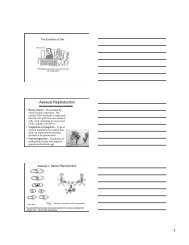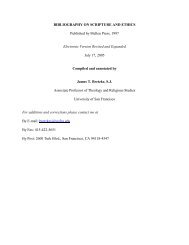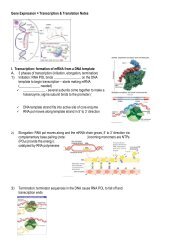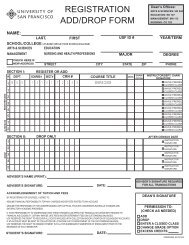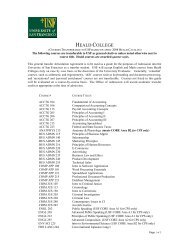Mitosis, Meiosis
Mitosis, Meiosis
Mitosis, Meiosis
You also want an ePaper? Increase the reach of your titles
YUMPU automatically turns print PDFs into web optimized ePapers that Google loves.
Cell Division, part 1<br />
I. Prokaryotes – Binary Fission<br />
II. Eukaryotes – <strong>Mitosis</strong><br />
A. Prophase<br />
B. Metaphase<br />
C. Anaphase<br />
D. Telophase<br />
Cellular Division Overview<br />
• Cell division requires<br />
– Duplication, organization and sorting of<br />
chromosomes<br />
Single-celled organisms: asexual reproduction<br />
Multi-celled organisms: growth, replacement<br />
I. Prokaryotes – Binary Fission<br />
Binary Fission: Prokaryotes, Yeast & Amoeba<br />
1
II. Eukaryotes:<br />
<strong>Mitosis</strong><br />
1. Karyokinesis –<br />
nuclear division<br />
2. Cytokinesis –<br />
cytoplasmic division<br />
Interphase<br />
• Comprises G1, S, G2 phases of cell cycle<br />
• Key event = replication of DNA during S,<br />
each chromosome will become two sister<br />
chromatids<br />
• Sister chromatids are<br />
mitosis<br />
1) interphase<br />
2) Prophase, prometaphase<br />
3) Metaphase<br />
4) Anaphase<br />
5) Telophase<br />
6) interphase<br />
2
MITOSIS<br />
<strong>Mitosis</strong> at the DNA level:<br />
whitefish blastula cells<br />
A. Prophase, prometaphase<br />
• First part of M phase<br />
Chromatin condenses into visible<br />
chromosomes, sister chromatids are joined at<br />
the centromere (genetically identical to one<br />
another)<br />
Nucleoli disappear, and nuclear membrane<br />
begins to break down<br />
Prometaphase –<br />
chromosomes begin to move<br />
Once the spindle<br />
apparatus is in place it<br />
attaches to the<br />
kinetochore on the<br />
centromere.<br />
3
B. Metaphase<br />
Each chromosome lines up on<br />
the equatorial plane<br />
(metaphase plate), led by the<br />
centromere via the spindle<br />
apparatus<br />
C. Anaphase<br />
Sister chromatids of each chromosome<br />
separate from each other and migrate<br />
to opposite ends of the cell<br />
Each centromeric region is split in two,<br />
once this occurs each chromatid is<br />
referred to as a<br />
Movement of each chromosome made<br />
possible by the spindle apparatus<br />
D. Telophase<br />
Cleavage furrow forms in<br />
animal cells,<br />
Cell plate in plants…<br />
• Final stage of mitosis<br />
Cytokinesis occurs – cytoplasm is partitioned<br />
to each half, cleavage furrow forms in animal<br />
cells; cell plate forms in plant cells<br />
4
SIGNIFICANCE:<br />
2n = 4<br />
Know the number of chromosomes/chromatids during each phase<br />
2n = 12, 24, 46… etc.<br />
http://www.pbs.org/wgbh/nova/miracle/divide.html<br />
http://www.biology.arizona.edu/cell_bio/tutorials/cell_cycle/main.html<br />
Cell Division, part 2 - <strong>Meiosis</strong><br />
I. Sexual reproduction requires gametes<br />
II. Meisos v. mitosis<br />
III. Prophase I<br />
A. Letoneme stage<br />
B. Zygoneme stage<br />
C. Pachyneme stage<br />
D. Diploneme stage<br />
E. Diakinesis<br />
IV. Metaphase, Anaphase, Telophase I<br />
V. The second meiotic division<br />
VI. Gamete development in animals<br />
A. Spermatogenesis<br />
B. Oogenesis<br />
I. Sexual reproduction requires gametes<br />
<strong>Meiosis</strong> = cell division that halves the<br />
genetic content for sexual reproduction<br />
<strong>Meiosis</strong> is critical to the successful sexual<br />
reproduction of all diploid organisms-<br />
•Mechanism by which 2n is reduced to n<br />
•Leads to the formation of gametes<br />
5
Gametes:<br />
• Haploid Gametes – isogamous vs.<br />
heterogamous<br />
II. <strong>Meiosis</strong>, different from mitosis:<br />
1) Two successive nuclear divisions, MI & MII, which<br />
produces haploid gametes that differ genetically<br />
• In many species, haploid (n) gametes<br />
are descended from germ cells that are<br />
originally diploid (2n) (via meiosis)<br />
– hapliod – they contain ½ the genetic<br />
content<br />
• Gametes then combine in fertilization to<br />
reconstitute the diploid complement<br />
found in parental cells<br />
6
III. Prophase I<br />
A. Leptotene stage<br />
• Chromatin begins to condense,<br />
chromosomes become visible<br />
• Chromomeres develop along each<br />
chromosome<br />
– Localized condensations<br />
• Homology search underway<br />
B. Zygotene stage<br />
• Continued chromosomal condensation<br />
• Homologous chromosomes undergo initial<br />
alignment, wherein "pairing sites" on the<br />
chromosomes are matched<br />
• Synaptonemal complex begins to form<br />
between the homologs<br />
• Upon completion of this stage, paired<br />
homologs are referred to<br />
7
C. Pachytene stage<br />
• Further development of synaptonemal complex<br />
occurs between the two members of each<br />
bivalent…leading to<br />
• Chromomeres align in the bivalents, producing a<br />
distinctive pattern for each pair (completes the<br />
“homology search”)<br />
D. Diplotene stage<br />
• Tetrads highly visible, each consisting<br />
of two pairs of sister chromatids<br />
• Within each teterad, each pair of sister<br />
chromatids begins to separate<br />
• One or more areas remain in contact<br />
where chromatids are intertwined =<br />
Crossing over at the DNA level –<br />
Holliday Structure<br />
8
Additional Crossing over info:<br />
Significance of CROSSING OVER:<br />
• The exchange is reciprocal, such that<br />
each chromosome gets the same region of<br />
the chromosome segment from the other<br />
parent that it donated to the other<br />
chromosome.<br />
• Crossovers are frequent and there is<br />
usually at least one on each chromosome<br />
and 3-4 on the larger chromosomes.<br />
E. Diakinesis<br />
Final stage of prophase I<br />
• Chromosomes pull farther apart, but<br />
nonsister chromatids remain loosely<br />
associated via the chaismata<br />
• Terminalization occurs = Chiasmata move<br />
toward the ends of the tetrad<br />
• Nucleolus and nuclear envelope break<br />
down & the two centromeres of each tetrad<br />
attach to spindle fibers<br />
9
IV. Metaphase, Anaphase & Telophase I<br />
• Metaphase I – tetrads move to the<br />
metaphase plate,<br />
• Anaphase I –<br />
• Telophase I – nuclear membrane forms<br />
around the dyads, cleavage furrow<br />
forms, nucleus enters short interphase<br />
tetrad<br />
dyad<br />
V. Second<br />
meitotic<br />
division<br />
Prophase II<br />
Metaphase II<br />
Anaphase II<br />
Telophase II<br />
monad<br />
10
nondisjunction<br />
Review questions<br />
1. A cell containing chromatids at the start of<br />
mitosis would, at its completion, produce cells<br />
containing how many chromosomes?<br />
2. What if the same cell undergoes meiosis –how<br />
many chromatids would there be in the daughter<br />
cells<br />
3. When ½ of the gametes produced are ,<br />
what has occurred during meiosis? (be specific)<br />
4. Which of the following is FALSE in comparing<br />
prophase I of meiosis and prophase of mitosis?<br />
Random assortment<br />
<strong>Meiosis</strong> produces new Combinations of genes in 3 ways:<br />
1. Random assortment of maternal and<br />
paternal chromosomes, and the alleles of<br />
genes they contain<br />
2. Recombination due to crossing over and<br />
exchange of chromosome parts between<br />
non-sister chromatids<br />
11
The number of possible combinations of maternal and<br />
paternal homologues is 2 n , where n = the haploid number of<br />
chromosomes. In this diagram, the haploid number is 3, and 8<br />
(2 3 ) different combinations are produced.<br />
VI. Gamete development in animals<br />
A. Spermatogenesis<br />
• takes place in testes<br />
• Germ cell = spermatogonium, enlarges<br />
to become a primary spermatocyte<br />
• Primary spermatocyte undergoes MI,<br />
producing 2 secondary spermatocytes –<br />
producing haploid spermatids<br />
• Spermatids undergo modifications –<br />
becoming spermatozoa<br />
B. Oogenesis<br />
• Occurs in ovary<br />
• Germ cell = oogonium, enlarges to form primary<br />
oocyte<br />
• Primary oocyte undergoes MI, producing 1 large<br />
secondary oocyte & 1 small polar body<br />
• Secondary oocyte undergoes MII, producing 1<br />
large haploid ootid & 1 small polar body<br />
• Ootid differentiates into mature ovum<br />
12








